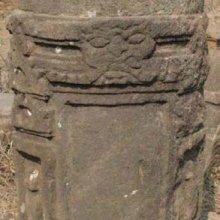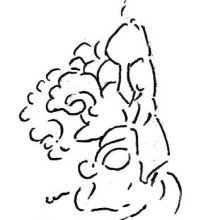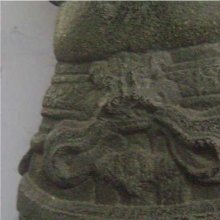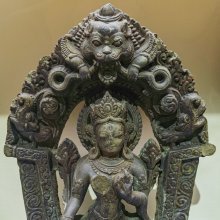Kirtimukha, Kīrtimukha, Kirti-mukha: 5 definitions
Introduction:
Kirtimukha means something in Hinduism, Sanskrit, the history of ancient India. If you want to know the exact meaning, history, etymology or English translation of this term then check out the descriptions on this page. Add your comment or reference to a book if you want to contribute to this summary article.
Images (photo gallery)
(+2 more images available)
In Hinduism
Shilpashastra (iconography)
Source: Wisdom Library: Śilpa-śāstraKīrtimukha (कीर्तिमुख, “face of glory”) refers to a face of a monster, vyāla, lion; it is often used as a nāsī finial.

Shilpashastra (शिल्पशास्त्र, śilpaśāstra) represents the ancient Indian science (shastra) of creative arts (shilpa) such as sculpture, iconography and painting. Closely related to Vastushastra (architecture), they often share the same literature.
Purana and Itihasa (epic history)
Source: archive.org: Puranic EncyclopediaKīrtimukha (कीर्तिमुख).—A Śiva gaṇa born out of the matted hair of Śiva with three faces, three tails, three legs and seven hands. The Lord at first asked him to live on corpses, but later on, in appreciation of his valour granted him the boon that if anyone saw the Lord without thinking first about Kīrtimukha, he would meet with his down-fall. (Padma Purāṇa, Uttara Khaṇḍa, Chapter 50).
Source: archive.org: Shiva Purana - English TranslationKīrtimukha (कीर्तिमुख) refers to one of the Gaṇas of Śiva, according to the Śivapurāṇa 2.5.19 (“Jalandhara’s emissary to Śiva”).—Accordingly, as Śiva says to one of his Gaṇas: “O great Gaṇa, you are blessed since you carried out my behest to the very letter. O excellent one, I am pleased with this action of yours. You shall hereafter be known by the title Kīrtimukha. You shall be my door-keeper. You shall be one of my great Gaṇas, very heroic and terrible to all wicked persons. You are my favourite. In the course of my worship, you too shall be worshipped always by my devotees. Those who do not worship you cannot be pleasing to me”.
Note: Kīrtimukha—the great Gaṇa of Śiva—is represented in sculpture by a trunkless head, and is installed beside the door in front of Śiva’s image.

The Purana (पुराण, purāṇas) refers to Sanskrit literature preserving ancient India’s vast cultural history, including historical legends, religious ceremonies, various arts and sciences. The eighteen mahapuranas total over 400,000 shlokas (metrical couplets) and date to at least several centuries BCE.
India history and geography
Source: Cologne Digital Sanskrit Dictionaries: Indian Epigraphical GlossaryKīrti-mukha.—(CII 4), a decorative motif. Note: kīrti-mukha is defined in the “Indian epigraphical glossary” as it can be found on ancient inscriptions commonly written in Sanskrit, Prakrit or Dravidian languages.

The history of India traces the identification of countries, villages, towns and other regions of India, as well as mythology, zoology, royal dynasties, rulers, tribes, local festivities and traditions and regional languages. Ancient India enjoyed religious freedom and encourages the path of Dharma, a concept common to Buddhism, Hinduism, and Jainism.
Languages of India and abroad
Kannada-English dictionary
Source: Alar: Kannada-English corpusKīrtimukha (ಕೀರ್ತಿಮುಖ):—
1) [noun] an ornamental metal ring or cone for wearing.
2) [noun] a demon-mask placed above the door of Śiva’s temple to drive away evil beings.
Kannada is a Dravidian language (as opposed to the Indo-European language family) mainly spoken in the southwestern region of India.
See also (Relevant definitions)
Partial matches: Mukha, Kirti.
Full-text: Mahagana, Shivapujana, Nasitorana, Dvaraka, Kastana, Shala, Panjara, Makaratorana, Dharmadhatu.
Relevant text
Search found 14 books and stories containing Kirtimukha, Kīrtimukha, Kirti-mukha, Kīrti-mukha; (plurals include: Kirtimukhas, Kīrtimukhas, mukhas). You can also click to the full overview containing English textual excerpts. Below are direct links for the most relevant articles:
Pallava period (Social and Cultural History) (by S. Krishnamurthy)
Waist-band (Kati-sutra) < [Chapter 4 - Material Culture of the People]
Crowns for Men (a): Kirita-makuta < [Chapter 4 - Material Culture of the People]
Head-dress of Men (Crowns) < [Chapter 4 - Material Culture of the People]
Stupas in Orissa (Study) (by Meenakshi Chauley)
Drum slabs at at Ratnagiri < [Chapter 4]
The Medhi Portion (of the Stupa) < [Chapter 4]
Minor Structural Stupas at Ratnagiri < [Chapter 4]
What does the Kirtimukha mean? < [Aug - Sept 1939]
The Golden Age of Hindu-Javanese Art < [September-October 1932]
Head-Gears in Hindu Art < [March 1937]
The Skanda Purana (by G. V. Tagare)
Chapter 17 - Dialogue between Nārada and Jalandhara < [Section 4 - Kārttikamāsa-māhātmya]
The Padma Purana (by N.A. Deshpande)
Chapter 10 - Jālandhara’s Messenger Rāhu Meets Śiva < [Section 6 - Uttara-Khaṇḍa (Concluding Section)]
Chapter 99 - Rāhu Acts as Messenger of Jalandhara < [Section 6 - Uttara-Khaṇḍa (Concluding Section)]
Temples of Munnur (Historical Study) (by R. Muthuraman)
Related products






